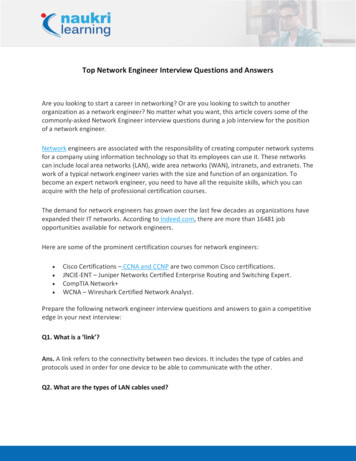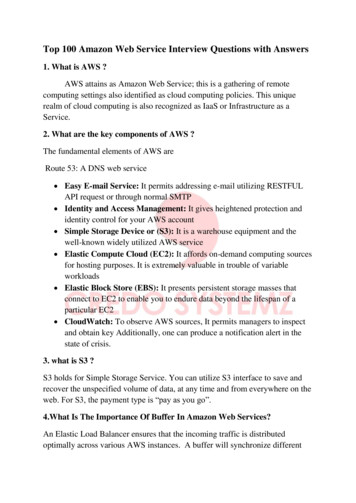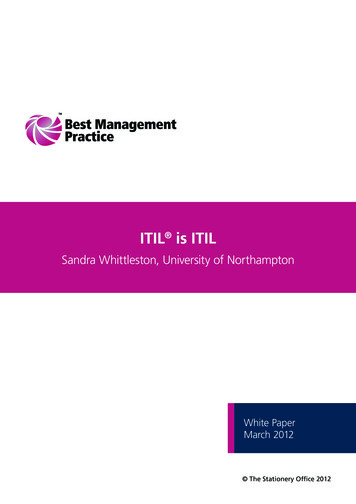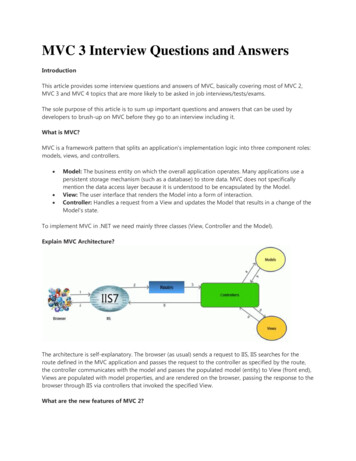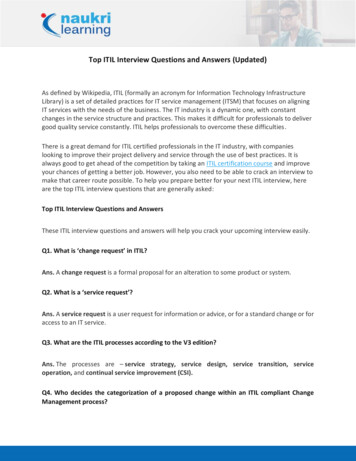
Transcription
Top ITIL Interview Questions and Answers (Updated)As defined by Wikipedia, ITIL (formally an acronym for Information Technology InfrastructureLibrary) is a set of detailed practices for IT service management (ITSM) that focuses on aligningIT services with the needs of the business. The IT industry is a dynamic one, with constantchanges in the service structure and practices. This makes it difficult for professionals to delivergood quality service constantly. ITIL helps professionals to overcome these difficulties.There is a great demand for ITIL certified professionals in the IT industry, with companieslooking to improve their project delivery and service through the use of best practices. It isalways good to get ahead of the competition by taking an ITIL certification course and improveyour chances of getting a better job. However, you also need to be able to crack an interview tomake that career route possible. To help you prepare better for your next ITIL interview, hereare the top ITIL interview questions that are generally asked:Top ITIL Interview Questions and AnswersThese ITIL interview questions and answers will help you crack your upcoming interview easily.Q1. What is ‘change request’ in ITIL?Ans. A change request is a formal proposal for an alteration to some product or system.Q2. What is a ‘service request’?Ans. A service request is a user request for information or advice, or for a standard change or foraccess to an IT service.Q3. What are the ITIL processes according to the V3 edition?Ans. The processes are – service strategy, service design, service transition, serviceoperation, and continual service improvement (CSI).Q4. Who decides the categorization of a proposed change within an ITIL compliant ChangeManagement process?
Ans. This is the task of the Change Manager. A Change Manager will play a key role in ensuringthat the projects (change initiatives) meet their objectives within timelines and said budgets byincreasing employee adoption and usage.Q5. What is SLA?Ans. A service level agreement (SLA) is a contract between a service provider (either internal orexternal) and the end-user that defines the level of service expected from the service provider.Q6. Name the 3 types of SLAs? A customer service level agreement is an agreement between the service provider and anexternal customer.An internal service level agreement is an agreement between you and an internalcustomer (such as another organization, site, or department).A vendor service level agreement is an agreement between you and the vendor.Also Read Ultimate Guide to ITILQ7. What two Service Management processes will most likely use a risk analysis andmanagement methodology?Ans. The two service management processes are- Availability Management and IT ServiceContinuity Management.Q8. What is an OLA?Ans. An operational-level agreement (OLA) defines the interdependent relationships in supportof a service-level agreement (SLA).Q9. What are the different Knowledge Management Systems (KMS)?Ans. They are – CMIS (Capacity Management Information System), AMIS (AvailabilityManagement Information System), KEDB (Known Error Database), CMDB (ConfigurationManagement Database), DML (Definitive Media Library), and SKMS (Service KnowledgeManagement System).
Q10. What is the relation between availability, availability service time, and downtime?Ans. Availability % (Available service time –downtime) / Available service timeAlso Read Trending Tech Skills to Master in 2020Q11. What is the Plan-Do-Check-Act (PDCA) cycle?Ans. The PDCA Cycle is a systematic series of steps for gaining valuable learning and knowledgefor the continual improvement of a product or process. Also known as the Deming Wheel, orDeming Cycle, the concept was first introduced to Dr. Deming by his mentor, Walter Shewhart ofthe famous Bell Laboratories in New York.Q12. Define the four phases in the PDSA cycle?Ans. Plan: Identifying and analyzing the problem.Do: Developing and testing a potential solution.Check: Measuring how effective the test solution was, and analyzing whether it could beimproved in any way.Act: Implementing the improved solution fully.Q13. What are the 7 R’s of change management?Ans. The Seven R’s of Change Management are:1.2.3.4.5.6.7.Who RAISED the change?What is the REASON for the change?What RETURN will the change deliver?Are there any RISKS when we do or do not carry out the change?What RESOURCES will be required to perform this change?Who is RESPONSIBLE for this change being performed?What RELATIONSHIPS are there between this and other changes?Q14. What type of information is stored in a CMDB?
Ans. CMDB contains contents that are intended to hold a collection of IT assets commonlyreferred to as configuration items (CI) as well as descriptive relationships between such assets.Q15. What is the difference between end-users and customers?Ans. An end-user or end customer directly receives the service or employs the product.A customer may or may not have the ability to choose between different products and suppliers.Q16. What is the difference between Expedite / Urgent Change and Emergency Change?Ans. An ITIL emergency change is the highest priority change that can be defined in anorganization. An expedited change is a change that meets a critical business requirementwithout the normal review and approval time.Q17. What do you mean by CAB?Ans. CAB (Change Advisory Board) is an authoritative and representative group of people whoare responsible for assessing, from both a business and a technical viewpoint, all high impactRequests for Change (RFCs).Q18. What is a PIR?Ans. Post Implementation Review (PIR) is that which takes place after a change or a project hasbeen implemented.Q19. Explain the service portfolio, service catalog, and service pipeline.Ans. Service portfolio refers to the services provided by service providers across all Market andall customers.Service Catalogue is the subset of the Service portfolio. Services ready to be offered to customersare listed in the service catalog.Service Pipeline consists of services under development.Q20. What is the freeze period?
Ans. Freeze period is a point in time in the development process after which the rules for makingchanges to the source code or related resources become stricter or the period during which thoserules are applied.Q21. What is the ITIL Lifecycle Model for services?Ans. The ITIL Lifecycle Model for services includes – StrategyDesignTransitionOperationContinual Service ImprovementQ22. Name the ITIL Models commonly adopted by the organizations.Ans. There are three types of ITIL models adopted by the organizations – Microsoft MOF (Microsoft Operations Framework)Hewlett-Packard (HP ITSM Reference Model)IBM (IT Process Model)Q23. What is ISO/IEC 27002?Ans. ISO/IEC 27002:2013 is an information security standard devised by the InternationalOrganization for Standardization (ISO) and by the International Electrotechnical Commission(IEC). This code of practice provides guidelines for organizational information security standardsand information security management practices.Q24. Give some examples of web-based service desk tools.Ans. Some example of web-based service desk tools include – BMCCA service deskOracle Service CloudServiceNowSolarWinds Web Help DeskSpiceworks Help Desk/Cloud Help Desk
TivoliQ25. Which ITIL processes belong to Service Strategy?Ans. ITIL processes belonging to Service Strategy include – Business relationship managementDemand managementFinancial managementService portfolio managementStrategy managementQ26. Which ITIL processes belong to Service Design?Ans. ITIL processes belonging to Service Design include – Availability ManagementCapacity ManagementDesign CoordinationInformation Security ManagementIT Service Continuity ManagementService Catalog ManagementService Level ManagementSupplier ManagementQ27. Which ITIL processes belong to Service Transition?Ans. ITIL processes belonging to Service Transition include – Change EvaluationChange ManagementRelease and Deployment ManagementService Asset and Configuration ManagementValidation and TestingTransition Planning and SupportQ28. Which ITIL processes belong to Service Operation?Ans. ITIL processes belonging to Service Operation include –
Access managementEvent managementIncident managementProblem managementService request fulfillmentQ29. What are ITSCM and BCP?Ans. ITSCM – IT Service Continuity Management is a practice that allows information securityprofessionals to develop IT infrastructure recovery plansBCP – Business Continuity Planning is the process by which a company creates a prevention andrecovery system from potential threats.Q30. What is ICT?Ans. Information and Communications Technology (ICT) is the infrastructure and componentsthat enable modern computing and refers to technologies that provide access to informationvia telecommunications.Q31. How are ICT and BCP related?Ans. BCP is a systematic process to predict, prevent, and manage ICT, and includes – IT disaster recovery planningWider IT resilience planningElements of IT infrastructure, and services related to (voice) telephonic and datacommunicationsQ32. What is CSF?Ans. Critical Success Factor or CSF refers to an element mandatory for the successfulachievement of a task. It drives any company forward and meets the business goals through itsstrategy.Q33. What is data leakage?
Ans. It refers to an unauthorized data transmission, either electronically or physically, from anorganization to any external destination or recipient. The most common forms of data leakageare through web, email, and mobile data storage devices.Q34. Which factors contribute to data leakage?Ans. The most common factors leading to data leakage include – Corrupt hard-driveHuman ErrorInadequate security control for shared drivesMalwareMisuseOutdated data securityPhysical theft of dataSystem misconfigurationTechnology errorUnprotected data back upQ35. How to prevent data leakage?Ans. Data leakage is a serious issue and thus there is a need to devise a proper strategy totackle. Data Loss Prevention (DLP) is a practice adopted by the organizations to safeguard theirdata. Under this practice, users are not allowed to send confidential or sensitive informationoutside of the enterprise network. This requires businesses to distinguish the rules that classifyconfidential and sensitive information such that any user does not disclose it maliciously oreven accidentally.Q36. What is an XSS attack?Ans. Cross-site Scripting (XSS) is another type of vulnerability that can be technically describedas a client-side code injection attack. In this particular attack, an attacker injects malicious datainto vulnerable websites. An attack happens when a user visits the web page, as malicious codeis then executed. This attack is very harmful to web application users.Q37. What are the different types of XSS attacks?Ans. There are three types of XSS attacks –
(i) Non-Persistent XSS attack – Here the data injected by an attacker is reflected in the responseand has a link with the XSS vector(ii) Persistent XSS attack – The most harmful type of attack, where the script executesautomatically the moment a user opens the page(iii) Document Object Model (DOM)-based XSS attack – An advanced type of XSS attack whichhappens when a web application writes data to the DOM without any sanitizationQ38. Why is information security policy important?Ans. Information security policy is important because it clearly outlines the responsibilities ofemployees about the safety and security of information, intellectual property, and data frompotential risks.Q39. What are the most popular work-around recovery options?Ans. The most popular work-around recovery options are – Fast recoveryGradual recoveryImmediate recoveryIntermediate recoveryManual workaroundReciprocal arrangementsQ40. What are the various service providers?Ans. Service providers that are a part of the ITIL process are –Internal Service Provider (ISP) – ISPs are the dedicated resources of a business unit and dealwith internal organization management.External Service Provider (ESP) – ESPs offer IT services to external customers and is not limitedto any business, individual, or market.Shared Services Units (SSU) – SSUs are autonomous special units and act as an extension ofISPs.
Also Explore Ethical Hacking CoursesQ41. What is the purpose of Service Transition?Ans. The purpose of Service Transition is: To ensure that a service can be managed, operated, and supported.It provides quality information about the change, release, and deploymentmanagement.It plans and manages capacity and resource requirements.Service transition also offers guidance on transferring the control of services betweencustomers and service providers.Q42. What is the difference between ITIL and COBIT?Ans. The differences between ITIL and COBIT are:ITILCOBIT1. It stands for Information TechnologyInfrastructure Library.1. It stands for Control Objectives forInformation and Related Technologies.2. ITIL is used for Information TechnologyService Management.2. COBIT is used for the integration ofinformation and technology.3. It enables you to implement the guidelines 3. It enables us to derive guidelines forof the business.business operations.4. It has 5 components: service strategy,service design, service transition, serviceoperation, and continuous serviceimprovement.4. Its main components include controlobjectives, frameworks, managementguidelines, maturity models, and processdescriptions.
5. ITIL follows a bottom-up approach,focusing more on IT service management.6. COBIT follows a top-down approach,focusing more on IT service governance.Q43. What are the objectives of Incident Management?Ans. The objectives of the incident management are: To ensure that standardized methods and procedures are used for the prompt andefficient response, documen
Top ITIL Interview Questions and Answers These ITIL interview questions and answers will help you crack your upcoming interview easily. Q1. What is Zchange request in ITIL? Ans. A change request is a formal proposal for an alteration to some product or system. Q2. What is a service request? Ans. A service request is a user request for information or advice, or for a standard change or for access to an IT service. Q3. What are the ITIL
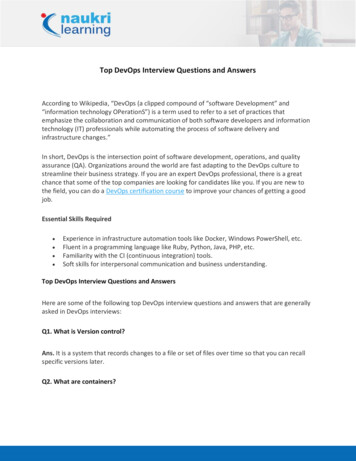
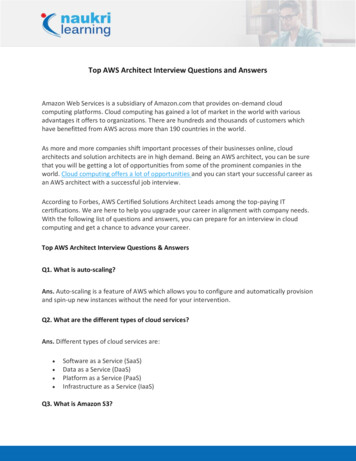
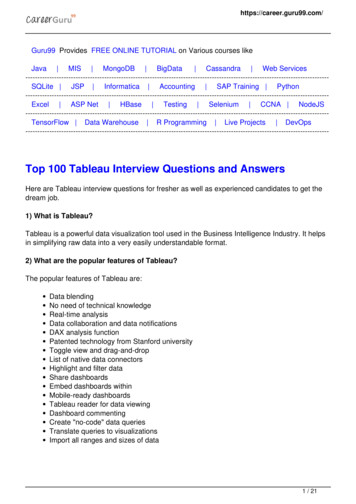
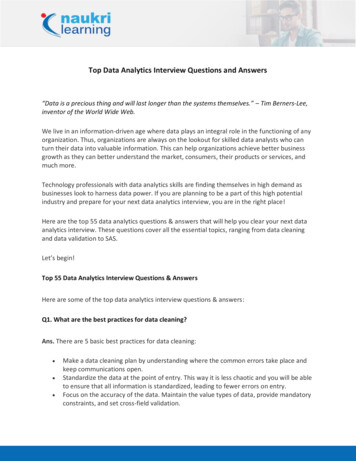
![Top Networking Interview Questions and Answers [Updated]](/img/3/top-networking-interview-questions-and-answers-updated.jpg)
